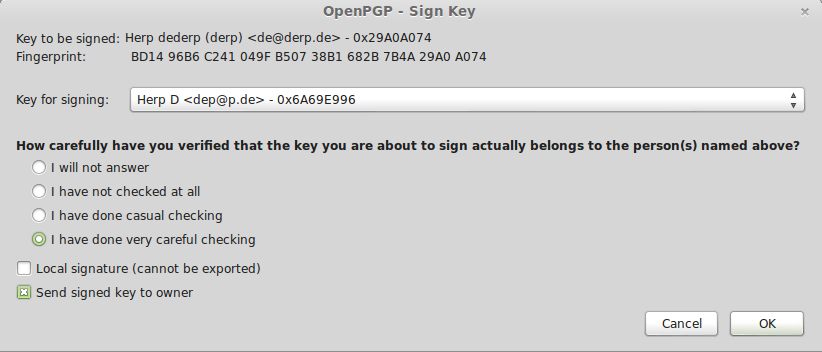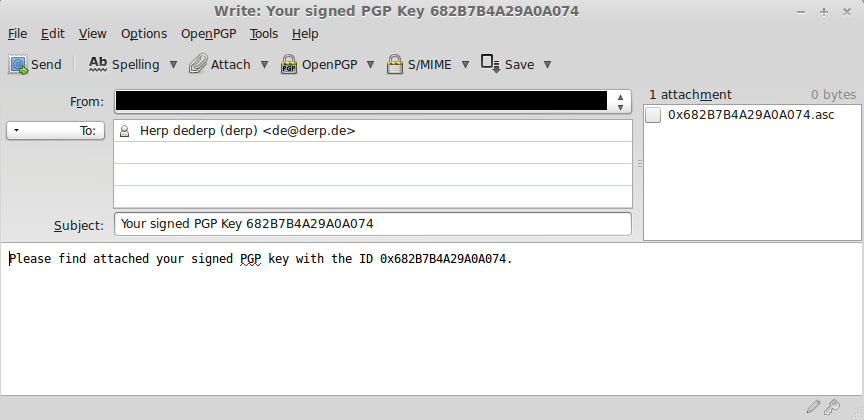During the last week, I worked on an interesting project. But instead of programming, this time it involved politics: I wrote a message to 403 german candidates to the European Parliament in the upcoming european elections, on the topic of “digital rights”.
It all started when I heard of WePromise.eu. In a nutshell: Candidates can promise to follow a charter of basic digital rights, supporting laws that strengthen these rights and opposing those that seek to reduce them. The charter contains a lot of very obvious, sensible points, and some less obvious but also very sensible points like export controls for surveillance / censorship equipment. Voters, in return, can promise to vote in the elections, and vote for a party whose candidates support these rights.
Now, my original plan was to write a physical letter to some candidates from my area, but when I asked the people behind WePromise for some material, they also supplied me with a list of all german candidates, including their eMail addresses. And since tools like Mail Merge make sending a lot of personalized eMails very easy, I decided to just write to each and every single candidate from that list. I quickly removed all candidates that had already pledged their support to the project, and all candidates without a known mail address, leaving me with 403 candidates, ranging from people almost guaranteed a spot in the european parliament to people on the 88th spot of a tiny party that may or may not get one or two candidates into the parliament. I quickly wrote up a message detailing the project, the aims, why I support it, and asking them to support it as well (or, alternatively, write me a quick mail detailing why they do not want to support it). I fed the message and the spreadsheet to Mail Merge, waited two minutes, and the mails were sent.
I received a bunch of autoreplies and some error messages concerning incorrect eMail addresses (which I tried to correct and update in my spreadsheet, sending the corrected addresses back to WePromise). Then I waited. That was one week ago.
Until today, I have received replies from over 25 candidates, ranging from the aforementioned 88th spot on the ÖDPs list to current members of the european parliament. The number of german candidates has jumped from 22 to 37, with a few more candidates having promised their signature and not yet appeared on the website. I had some very interesting discussions concerning the advantages and disadvantages of online anonymity, during which I convinced at least one candidate to change his views (two more discussions are ongoing). I also received three replies from parties that are generally not considered to be very pro-internet (all of them stating that they would not sign the pledge, but would “continue to fight for data protection”, and all of them from supporters of data retention laws. I’ll leave you to figure out how the hell that is supposed to work, because I have no idea).
So, some statistics from one week into the project:
- 15 new signatures (6x Die Grünen, 4x ÖDP, 3x SPD, 2x FDP)
- 4 signatures pledged that have not yet appeared on the website (2x Linke, 2x SPD, 1x ÖDP)
- 6 refusals for different, mostly acceptable reasons (2x CSU, 2x AfD, 1x CDU, 1x SPD)
As you can see, a large majority of candidates has never replied. That was to be expected. Still, it has been quite an interesting experience, interacting directly with people that may, in the near future, be called upon to represent my interests in the european parliament.
I can only recommend contacting (some of) your candidates. Ask them their opinion on a cause close to your heart, maybe even have a (civil!) discussion on the matter if they have a different opinion. My experience has shown me that, at least in the smaller parties, you can actually change someones opinion on some matters. And who knows, maybe the candidate will actually be elected to the european parliament. And maybe, just maybe, your discussion will change their vote on a crucial issue… And wouldn’t that be worth the 10 minutes it takes you to write up a mail?

